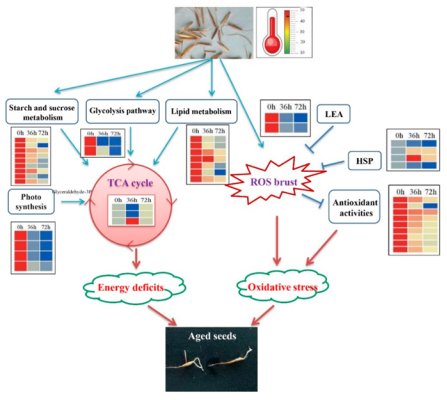Comparative Physiological and Proteomic Analysis Reveals Different Involvement of Proteins during Artificial Aging of Siberian Wildrye Seeds
2022年03月11日 17:36
DOI:10.3390/plants9101370
Xiong Lei,Wenhui Liu,Junming Zhao,Minghong You,Xiao Ma
发表期刊:Plants
网页链接:https://www.mdpi.com/2223-7747/9/10/1370
Abstract:
Seed aging has an important effect on the germplasm preservation and industrialized production of Siberian wildrye (Elymus sibiricus) in the Qinghai-Tibet Plateau. However, so far its underlying molecular mechanisms still largely remain unknown. To shed light on this topic, one-year stored seeds of E. sibiricus were exposed to artificial aging treatments (AAT), followed by seed vigor characteristics and physiological status monitoring. Then global proteomics analysis was undertaken by the tandem mass tags (TMT) technique, and the proteins were quantified with liquid chromatography-tandem mass spectrometry on three aging time points (0 h, 36 h and 72 h). Finally, we verified the expression of related proteins by parallel reaction monitoring (PRM). Our results demonstrated that the seed vigor decreased remarkably in response to artificial aging, but the relative ion-leakage and malondialdehyde content, superoxide anion and hydrogen peroxide showed the opposite situation. Proteomic results showed that a total of 4169 proteins were identified and quantified. Gene Ontology (GO) analysis and Kyoto Encyclopedia of Genes and Genomes (KEGG) analysis indicated that a series of key pathways including carbohydrate metabolism, lipid metabolism, and antioxidant activity were severely damaged by aging treatments. Numerous key proteins such as glyceraldehyde triphosphate glyceraldehyde dehydrogenase, succinate dehydrogenase, lipoxygenase, peroxidase, glutathione-s-transferase and late embryogenesis abundant proteins were significantly down-regulated. However, the up-regulation of the heat shock protein family has made a positive contribution to oxidative stress resistance in seeds. This study provides a useful catalog of the E. sibiricus proteomes with insights into the future genetic improvement of seed storability.
